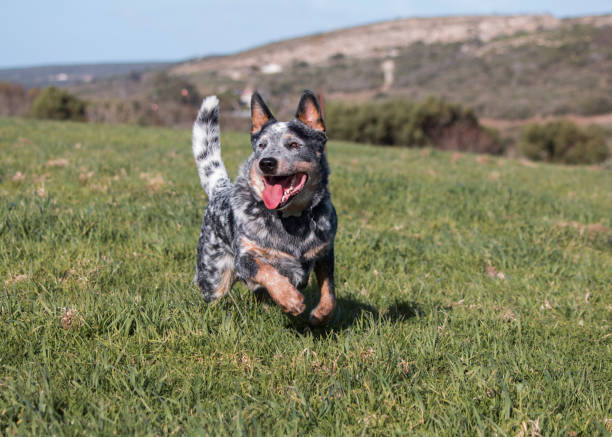Australian Cattle Dog

Breed History:
The Australian Cattle Dog (ACD) was developed in the 19th century in Australia to herd cattle over long distances and rugged terrain. Early settlers needed a tough, intelligent, and tireless dog. To achieve this, breeders crossed herding dogs, Dingos, Smooth Collies, Bull Terriers, and later, Dalmatians and Kelpies.
The result was a hardy, energetic herder known for stamina, agility, and fierce intelligence. Originally called the Blue or Red Heeler, depending on coat colour, the breed became instrumental in developing Australia’s cattle industry. It was officially recognised by the AKC in 1980.
|
Gender |
Height |
Weight |
|
Male |
46-51 cm |
20-28 kg |
|
Female |
43-48 cm |
18-25 kg |
Size: Medium
Life Expectancy: 12–16 years

Breed Appearance:
The Australian Cattle Dog has a strong, compact, and muscular build, ideal for endurance and quick reflexes. It has a broad skull, pricked ears, and alert, expressive eyes that reflect its high intelligence.
Its short, weather-resistant double coat comes in two main colours: blue (with or without black, tan, or white markings) and red speckle. Puppies are born white and develop their adult colouring later. The tail is carried low and often has a white tip.
Breed Type – Herding/Working:
This breed is a natural herder, bred for long hours of work in tough conditions. It’s intense, alert, and incredibly focused, with a strong instinct to control movement, whether of cattle, other pets, or even people.
Though initially reserved with strangers, the ACD is deeply loyal to its family, forming strong bonds. It is protective and often serves as an effective watchdog. This breed needs a job or purpose to stay mentally balanced.

Training:
The ACD is highly intelligent and eager to learn, but also independent and sometimes stubborn. Training must be firm, consistent, and mentally stimulating.
This breed excels in obedience, agility, herding trials, and even canine sports. Early socialisation is vital to reduce wariness with strangers and curb overprotectiveness.
Health & Care:
Australian Cattle Dogs are generally very healthy, but can be prone to:
-
Progressive retinal atrophy (PRA)
-
Deafness (congenital)
-
Hip and elbow dysplasia
-
Osteochondritis dissecans (OCD)
Responsible breeders test for these issues. Regular vet checkups, a balanced diet, and keeping the dog lean help prolong life. ACDs are slow to age and often remain active into their senior years.

Living Conditions:
The ACD is best suited to active homes with plenty of space, such as rural or suburban environments. It can live in a house with a secure yard but is not ideal for apartment living unless very well exercised.
It does best with owners who understand working breeds and can meet its physical and mental needs. Without stimulation, the ACD can become destructive or neurotic.
Exercise:
This breed requires extensive daily exercise:
-
Long walks or runs
-
Interactive games like fetch or frisbee
-
Jobs around the house or farm
-
Agility or herding training
Mental stimulation is just as important as physical activity. A bored ACD will find ways to entertain itself, often by herding kids, chewing furniture, or escaping yards.
Grooming:
Low-maintenance coat, but regular upkeep is helpful:
-
Weekly brushing to remove dead hair
-
More frequent brushing during seasonal shedding
-
Bathing only as needed—its coat repels dirt well
-
Routine ear cleaning, dental care, and nail trimming
The ACD is a naturally clean dog with minimal odour.

Advantages:
-
Extremely intelligent and trainable
-
Loyal, protective, and reliable
-
Excellent work ethic—thrives in a job
-
Hardy and long-lived for a medium breed
-
Low grooming needs and clean habits
-
Performs well in obedience and agility sports
Disadvantages:
-
High exercise and stimulation needs
-
Can be wary or aloof with strangers
-
May nip or herd children and pets
-
Not ideal for first-time or sedentary owners
-
Needs firm boundaries and consistent training
-
Can be destructive if bored or under-exercised

